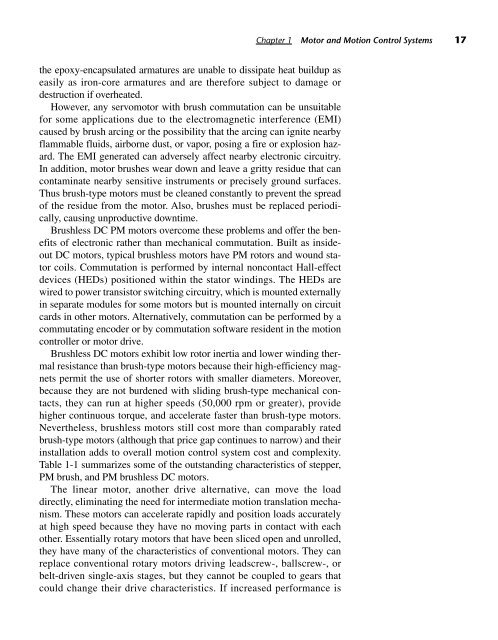Robot Mechanisms and Mechanical Devices Illustrated - Profe Saul
Robot Mechanisms and Mechanical Devices Illustrated - Profe Saul
Robot Mechanisms and Mechanical Devices Illustrated - Profe Saul
Create successful ePaper yourself
Turn your PDF publications into a flip-book with our unique Google optimized e-Paper software.
the epoxy-encapsulated armatures are unable to dissipate heat buildup as<br />
easily as iron-core armatures <strong>and</strong> are therefore subject to damage or<br />
destruction if overheated.<br />
However, any servomotor with brush commutation can be unsuitable<br />
for some applications due to the electromagnetic interference (EMI)<br />
caused by brush arcing or the possibility that the arcing can ignite nearby<br />
flammable fluids, airborne dust, or vapor, posing a fire or explosion hazard.<br />
The EMI generated can adversely affect nearby electronic circuitry.<br />
In addition, motor brushes wear down <strong>and</strong> leave a gritty residue that can<br />
contaminate nearby sensitive instruments or precisely ground surfaces.<br />
Thus brush-type motors must be cleaned constantly to prevent the spread<br />
of the residue from the motor. Also, brushes must be replaced periodically,<br />
causing unproductive downtime.<br />
Brushless DC PM motors overcome these problems <strong>and</strong> offer the benefits<br />
of electronic rather than mechanical commutation. Built as insideout<br />
DC motors, typical brushless motors have PM rotors <strong>and</strong> wound stator<br />
coils. Commutation is performed by internal noncontact Hall-effect<br />
devices (HEDs) positioned within the stator windings. The HEDs are<br />
wired to power transistor switching circuitry, which is mounted externally<br />
in separate modules for some motors but is mounted internally on circuit<br />
cards in other motors. Alternatively, commutation can be performed by a<br />
commutating encoder or by commutation software resident in the motion<br />
controller or motor drive.<br />
Brushless DC motors exhibit low rotor inertia <strong>and</strong> lower winding thermal<br />
resistance than brush-type motors because their high-efficiency magnets<br />
permit the use of shorter rotors with smaller diameters. Moreover,<br />
because they are not burdened with sliding brush-type mechanical contacts,<br />
they can run at higher speeds (50,000 rpm or greater), provide<br />
higher continuous torque, <strong>and</strong> accelerate faster than brush-type motors.<br />
Nevertheless, brushless motors still cost more than comparably rated<br />
brush-type motors (although that price gap continues to narrow) <strong>and</strong> their<br />
installation adds to overall motion control system cost <strong>and</strong> complexity.<br />
Table 1-1 summarizes some of the outst<strong>and</strong>ing characteristics of stepper,<br />
PM brush, <strong>and</strong> PM brushless DC motors.<br />
The linear motor, another drive alternative, can move the load<br />
directly, eliminating the need for intermediate motion translation mechanism.<br />
These motors can accelerate rapidly <strong>and</strong> position loads accurately<br />
at high speed because they have no moving parts in contact with each<br />
other. Essentially rotary motors that have been sliced open <strong>and</strong> unrolled,<br />
they have many of the characteristics of conventional motors. They can<br />
replace conventional rotary motors driving leadscrew-, ballscrew-, or<br />
belt-driven single-axis stages, but they cannot be coupled to gears that<br />
could change their drive characteristics. If increased performance is<br />
Chapter 1 Motor <strong>and</strong> Motion Control Systems 17

















